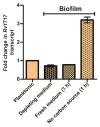Rv1717 Is a Cell Wall - Associated β-Galactosidase of Mycobacterium tuberculosis That Is Involved in Biofilm Dispersion
- PMID: 33584576
- PMCID: PMC7873859
- DOI: 10.3389/fmicb.2020.611122
Rv1717 Is a Cell Wall - Associated β-Galactosidase of Mycobacterium tuberculosis That Is Involved in Biofilm Dispersion
Abstract
Understanding the function of conserved hypothetical protein (CHP)s expressed by a pathogen in the infected host can lead to better understanding of its pathogenesis. The present work describes the functional characterization of a CHP, Rv1717 of Mycobacterium tuberculosis (Mtb). Rv1717 has been previously reported to be upregulated in TB patient lungs. Rv1717 belongs to the cupin superfamily of functionally diverse proteins, several of them being carbohydrate handling proteins. Bioinformatic analysis of the amino acid sequence revealed similarity to glycosyl hydrolases. Enzymatic studies with recombinant Rv1717 purified from Escherichia coli showed that the protein is a β-D-galactosidase specific for pyranose form rather than the furanose form. We expressed the protein in Mycobacterium smegmatis (Msm), which lacks its ortholog. In Msm Rv1717 , the protein was found to localize to the cell wall (CW) with a preference to the poles. Msm Rv1717 showed significant changes in colony morphology and cell surface properties. Most striking observation was its unusual Congo red colony morphotype, reduced ability to form biofilms, pellicles and autoagglutinate. Exogenous Rv1717 not only prevented biofilm formation in Msm, but also degraded preformed biofilms, suggesting that its substrate likely exists in the exopolysaccharides of the biofilm matrix. Presence of galactose in the extracellular polymeric substance (EPS) has not been reported before and hence we used the galactose-specific Wisteria floribunda lectin (WFL) to test the same. The lectin extensively bound to Msm and Mtb EPS, but not the bacterium per se. Purified Rv1717 also hydrolyzed exopolysaccharides extracted from Msm biofilm. Eventually, to decipher its role in Mtb, we downregulated its expression and demonstrate that the strain is unable to disperse from in vitro biofilms, unlike the wild type. Biofilms exposed to carbon starvation showed a sudden upregulation of Rv1717 transcripts supporting the potential role of Rv1717 in Mtb dispersing from a deteriorating biofilm.
Keywords: biofilm; biofilm dispersion; extracellular polymeric substance; galactosidase; mycobacteria.
Copyright © 2021 Bharti, Maurya, Venugopal, Singh, Akhtar and Krishnan.
Conflict of interest statement
The authors declare that the research was conducted in the absence of any commercial or financial relationships that could be construed as a potential conflict of interest.
Figures








Similar articles
-
Media component bovine serum albumin facilitates the formation of mycobacterial biofilms in response to reductive stress.BMC Microbiol. 2023 Apr 20;23(1):111. doi: 10.1186/s12866-023-02853-6. BMC Microbiol. 2023. PMID: 37081437 Free PMC article.
-
The extracellular matrix of mycobacterial biofilms: could we shorten the treatment of mycobacterial infections?Microb Cell. 2019 Jan 18;6(2):105-122. doi: 10.15698/mic2019.02.667. Microb Cell. 2019. PMID: 30740456 Free PMC article. Review.
-
Down-regulation of PE11, a cell wall associated esterase, enhances the biofilm growth of Mycobacterium tuberculosis and reduces cell wall virulence lipid levels.Microbiology (Reading). 2017 Jan;163(1):52-61. doi: 10.1099/mic.0.000417. Microbiology (Reading). 2017. PMID: 28198348
-
Expression of Mycobacterium tuberculosis NLPC/p60 family protein Rv0024 induce biofilm formation and resistance against cell wall acting anti-tuberculosis drugs in Mycobacterium smegmatis.Microbes Infect. 2016 Apr;18(4):224-36. doi: 10.1016/j.micinf.2015.11.007. Epub 2015 Dec 17. Microbes Infect. 2016. PMID: 26706821
-
Mycobacterium biofilms: factors involved in development, dispersal, and therapeutic strategies against biofilm-relevant pathogens.Crit Rev Eukaryot Gene Expr. 2014;24(3):269-79. doi: 10.1615/critreveukaryotgeneexpr.2014010545. Crit Rev Eukaryot Gene Expr. 2014. PMID: 25072151 Review.
Cited by
-
Immunobiology of tubercle bacilli and prospects of immunomodulatory drugs to tackle tuberculosis (TB) and other non-tubercular mycobacterial infections.Immunobiology. 2022 May;227(3):152224. doi: 10.1016/j.imbio.2022.152224. Epub 2022 May 5. Immunobiology. 2022. PMID: 35533535 Free PMC article. Review.
-
c-di-AMP Accumulation Regulates Growth, Metabolism, and Immunogenicity of Mycobacterium smegmatis.Front Microbiol. 2022 May 24;13:865045. doi: 10.3389/fmicb.2022.865045. eCollection 2022. Front Microbiol. 2022. PMID: 35685938 Free PMC article.
-
Involvement of Mycobacterium smegmatis small noncoding RNA B11 in triacylglycerol accumulation and altered cell wall permeability.BMC Microbiol. 2025 Mar 8;25(1):124. doi: 10.1186/s12866-025-03826-7. BMC Microbiol. 2025. PMID: 40057673 Free PMC article.
-
Targeted Anti-Biofilm Therapy: Dissecting Targets in the Biofilm Life Cycle.Pharmaceuticals (Basel). 2022 Oct 12;15(10):1253. doi: 10.3390/ph15101253. Pharmaceuticals (Basel). 2022. PMID: 36297365 Free PMC article. Review.
-
Rapid adaptation of a complex trait during experimental evolution of Mycobacterium tuberculosis.Elife. 2022 Jun 21;11:e78454. doi: 10.7554/eLife.78454. Elife. 2022. PMID: 35726854 Free PMC article.
References
LinkOut - more resources
Full Text Sources
Other Literature Sources

